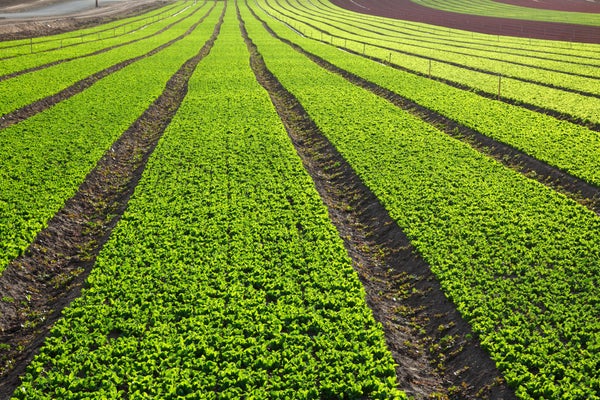Think of California smog, and you might picture brown haze over a crowded freeway. But farmland in the Golden State emits about the same amount of certain pollution-forming gases as on-road vehicles, a new study shows. That’s much more than researchers had previously estimated, bumping up estimates of the total production of these gases in the state by as much as 51 percent.
Farms in California’s Central Valley, which produce most of the fruits and vegetables in the U.S., are heavily fertilized during multiple crop rotations throughout the year. But in most intensive farming operations, crops are believed to take up only about half of the nitrogen in the fertilizer applied. Microbes in the soil digest some of what remains to produce nitrogen oxides, or NOx. These gases react with light and organic matter in the atmosphere to make ozone. They also promote the formation of airborne particulate matter. NOx—as well as ozone and particulates—can threaten respiratory health.
Maya Almaraz, a postdoctoral researcher at the University of California, Davis, decided to investigate farmland’s contribution to air pollution after noticing that five of the top 10 U.S. cities for ozone pollution are in the Central Valley. Whereas catalytic converters and other engine improvements have helped lower NOx levels in Los Angeles and San Francisco considerably in recent years, “we’re not seeing those leaps and bounds in the Central Valley and other rural areas,” she says. Many factors—including diesel truck traffic, oil production and geographical setting—contribute to the problem in a basin that deters air circulation and traps pollutants. But Almaraz thought the area’s vast stretches of farmland might also be involved.
On supporting science journalism
If you're enjoying this article, consider supporting our award-winning journalism by subscribing. By purchasing a subscription you are helping to ensure the future of impactful stories about the discoveries and ideas shaping our world today.
To test this idea, she and her colleagues used a model that takes into account nitrogen input, climate, soil moisture levels and other factors to predict soil microbes’ production of the gases. The researchers found that 20 to 32 percent of the state’s NOx emissions come from cropland, compared with 29 to 36 percent from on-road motor vehicles, according to a report published last week in Science Advances. These results are significantly higher than the California Air Resources Board (CARB)’s previous estimate of about 4 percent (pdf), which was based on data from farms within 200 kilometers of Sacramento. To check their results, the team collected air samples on six light aircraft flights over the San Joaquin Valley between Fresno and Visalia, a heavily farmed region within the Central Valley. They used those readings to estimate NOx emissions from soil, after subtracting local estimates from the CARB California Emissions Projection Analysis Model of NOx emissions derived from fossil fuels. The results were similar to those predicted by the model for that region.
Fertilized farmland contributes substantially to NOx production in many other crop-growing regions, although the levels often depend on the growing season. In the Midwest NOx emissions from soils have been estimated to comprise up to 40 percent of the total emissions in the summertime.
Ronald Cohen, an atmospheric scientist at the University of California, Berkeley who was not part of the research, calls the new study “provocative,” and says it shows agricultural fertilizer contributes a significant fraction of total NOx emissions in California. It is important to verify the results with more field measurements, he says. (This is one of the things the researchers plan to do next.) Still, Cohen adds, “We need to think about these sources more carefully as we try to reduce human exposure to air pollution.” One way to do that would be by continuing to reduce output from cars, trucks and planes, Cohen says. Changes to farming practices might also help.
These include monitoring plants’ uptake of fertilizer so it can be applied more efficiently, as well as switching to slow-release fertilizers, using cover crops to absorb excess nitrogen or applying nitrification inhibitors—chemicals that stop microbes from producing NOx. Many of these methods are promoted through the California Department of Food and Agriculture’s Fertilizer Research and Education Program, according to Steve Lyle, the department’s director of public affairs.
“Farmers have a long history of adjusting their practices in response to emerging science, and we will watch to see if further studies verify the results reported here,” says Jim Houston, manager of governmental affairs for the California Farm Bureau Federation, a nonprofit organization that advocates for farmers and ranchers. “It’s important to note that most of the steps the study suggests are already underway. Farmers want to use the appropriate amounts of fertilizer and have long relied on expertise from the University of California in making those applications.”
Almaraz is also collaborating with public health researchers at U.C. Davis to see how this pollution might be affecting human health. “NOx tends to be pretty localized pollution,” she says, “so the people most affected by this are going to be the ones living in these farming areas.”
